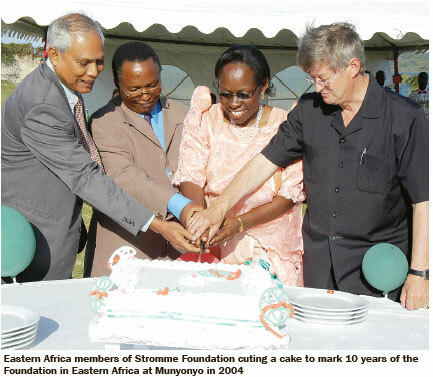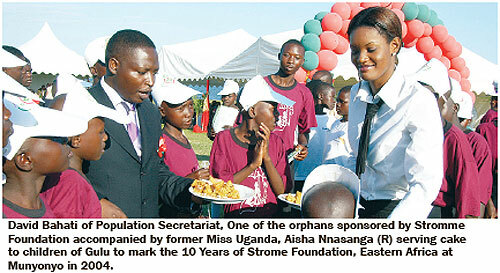STROMME foundation gives hope to the poor-Joint Nordic National Day Supplement
Smiles, ambition and hope has replaced the curses and negative beliefs of a number of people in the hard to reach villages in Uganda
By Thomas Pere
Smiles, ambition and hope has replaced the curses and negative beliefs of a number of people in the hard to reach villages in Uganda, thanks to Stromme Foundation. Since the organisation got in touch with, them, many have experienced a tremendous change in their lives.
History
Stromme Foundation is a Norwegian based International development organisation that helps poor people in Africa, Asian and South America to cross the poverty line.

In east Africa, the foundation started work in the 1980s and opened its regional office in Kampala in 1994, now it is in Uganda, Kenya, Tanzania and South Sudan. Priscilla Serukka the Regional Director, Stromme Foundation East Africa says the foundation came to Uganda because it was coming out of social economic and political collapse.
There was compassion for the affected people after many years of bad rule. It initially worked as a charity and the early interventions included paying fees for orphans’ and the poor to a tune of 12,000 people. Although it evolved over the years to avoid duplication especially when Universal Primary Education (UPE) came in.
Activities
“Since the vision of Stromme Foundation is to have a world free from poverty. It is committed to empowering people to overcome the root causes of poverty,” says Serukka. It works with local partners through different interventions. It does this by giving funds and building capacity where it puts emphasis on empowerment of people to take charge of their lives.

According to Stromme Foundation, Poverty is lack of basic needs, social exclusion, powerlessness, and vulnerability. Together with partners who share this mission, Stromme works with the poor to facilitate their efforts to cross the poverty line.
Local partners are grassroot organisations which are non-governmental organisations (NGOs) and community based organisations. Serukka says with their interventions, people have been empowered to realise their rights. We do this by working with governmentaided schools in poor hard to reach communities.
It includes: the rights of children to be at school, get quality education, complete basic education, ensure increased enrolment, retention; and rights to access relevant and appropriate financial services. The Foundation also realised a number of groups need informal education for life skills and occupational skills.
This includes people who have missed or dropped from school like adolescent girls so that they can earn to take care of their babies. “We also focus on economic empowerment and building entrepreneurship skills in the communities. We realised one reason people drop out of school is poverty where they cannot afford books, food, uniform and even primary health care,” says Serukka.
This is addressed by working with microfinance institutions in three main ways. By giving loans to microfinance institutions at quasi market interests rates for the poor communities to start small or grow their existing small businesses with the aim of increasing household incomes and livelihoods.
In more poor communities where microfinance institutions don’t reach, we support self-help groups which are composed of poor communities. In these groups, the poor are facilitated to save and lend themselves from the pool of savings.
The groups are also used as platforms to address other issues which perpetuate poverty in these communities. They include: family planning, family health care, HIV, environment management, and sensitisation on the importance of education and entrepreneurship.
Groups are also facilitated to advocate for and address some of their concerns in the communities by partnering with local authorities. This is in areas like roads where they work with support from local government.
Achievements
Serukka says in 2011, Stromme supported 25 microfinance institutions with a portfolio of about sh20.5b in loans that reaches 70,000 people. It is also supported by 17 people owned organisations which reaches 60,000 people where 76% are women.
Through the microfinance work, poor people were able to mobilise a cumulative savings of sh5.6b in a year. They also managed to successfully improve access to education for their members’ children. Furthermore, households’ incomes improved. Women have gained more control of resources and have started small business reducing their dependency and vulnerability.
It supports nine education partners and informal primary education. It also supports 58 primary schools which are based in poor hard to reach communities and early childhood centers’ across the region. Last year,in bid to improve the learning environment of poor communities, 12 new classrooms were built, 27 were renovated and teachers houses constructed.
Furthermore, in stromme supported schools, 2,224 pupils sat PLE and out of these schools 92% attained grades I-IV and were able to join secondary. Through the foundation, 375 out of school adolescent girls were recruited into adolescent girls empowerment programme in Abim and Amoru districts.
The girls underwent a nine month training where they attained basic literacy and numerous skills in reproductive health, rights, PHC, vocational skills, agriculture and horticulture. Also 1,233 Parents teachers’ association members (PTA) and school management were trained in local resource mobilisation and protection of rights of children.
Challenges
In spite of the achievements, Serukka says the foundation is facing a number of challenges. Among them is the high inflation which is hampering work and pricing in microfinance interventions.
Furthermore, some areas were hit by drought which affected participation of the beneficiaries’. And some teachers in the beneficiary schools walk long distances this has made the pupil-teacher contact and at times fail to cover the syllabus.
She says, culture and traditional practices in some communities also has a negative impact on education. There is also the challenge of limited capacity of some partners due to poor institutional infrastructure, boards, managements and staff; and lastly inadequate funds.
Future plans
Serukka says, “We are planning to have a synergy between education and microfinance to increase impact in the lives of poor. Secondly the foundation is going work more with other development partners and consortiums.”
We hope to have a master plan to integrate issues of food security and environment management, to actively support advocacy in the communities so that resources can trickle down to the intended beneficiaries.
Relationship with Nordic countries
The bulk of the funding of the foundation comes from Norway by NORAD and other corporations and individuals; and some from Sweden. Out of the Nordic countries it comes from CORDAID a Dutch development organisation.
“We are grateful to the Nordic countries for their generosity, flexibility and believing in us. Other organisations bring their own experts, but for them they have trusted us, we appreciate their genuine partnership,” says Serekka.
